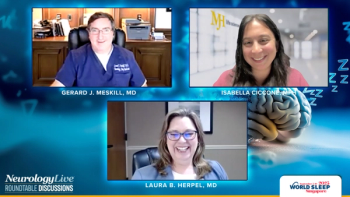
Despite Positive Efficacy, Safety Concerns Halt Phase 2 Trial of Orexin Receptor TAK-994 in Narcolepsy Type 1
The phase 2 trial represented the first-ever clinical data to be published of an oral orexin agonist for patients living with narcolepsy type 1.
Published in The New England Journal of Medicine, findings from a phase 2 study (NCT04096560) assessing TAK-994 (Takeda), an orexin receptor 2 (OX2R) agonist, showed greater improvements on measures of sleepiness and cataplexy compared with placebo over 8 weeks in a cohort of patients with narcolepsy type 1 (NT1).1 Despite the positive efficacy results, treatment with the therapy was associated with hepatotoxic effects which led termination of the trial.
Among 73 patients diagnosed with NT1, changes in mean sleep latency on Maintenance of Wakefulness Test (MWT), the primary end point, for up to 8 weeks were available in 56% of patients. At the conclusion of the trial, investigators observed least square (LS) mean changes of -2.5 minutes for placebo vs 23.9, 27.4, and 32.6 minutes, respectively, for 30 mg,90 mg, and 180 mg twice daily of TAK-994 (placebo-adjusted LS mean estimated: 30 mg: 26.4 min; 90 mg: 29.9 min; 180 mg: 35.0 min;(all comparisons, P<.001).
“There is significant unmet need for patients with narcolepsy, a chronic neurologic disease caused by severe loss or absence of the neuropeptide orexin, also known as hypocretin. Today, most patients with NT1 require multiple therapies that only manage excessive daytime sleepiness and cataplexy. Moreover, none of the available agents target the underlying cause of the disease,” principal investigator
In the sample of adult patients with confirmed NT1 enrolled, 17 were randomly assigned TAK-994 30 mg twice daily, 20 assigned 90 mg twice daily, 19 assigned 180 mg twice daily, and 17 assigned placebo. The primary end point in the trial was change in mean sleep latency minutes on the MWT from baseline to week 8 (test range, 0-40; normal, at least 20 minutes). The secondary end points were the change in Epworth Sleepiness Scale (ESS) score (scale range, 0-24; normal less than 10), weekly cataplexy rate (WCR), and treatment-emergent adverse events (TEAEs).
“Although this study was not designed to compare TAK-994, the first-in-class oral OX2R agonist, with other narcolepsy drugs, its effectiveness on objective measures of wakefulness, self-reported assessment of daytime sleepiness, and frequency of cataplexy was impressive. However, TAK-994 was associated with hepatotoxicity, therefore studies with new well tolerated OX2R agonists are strongly requested,” Dauvilliers said in a statement.2
READ MORE:
At week 8, among those with available ESS data (58% of cohort), investigators observed LS mean changes of -2.1 for placebo, in comparison with changes of -12.2, -13.5, and -15.1 (placebo-adjusted LS mean estimated of -10.1, -11.4, and -13.0), respectively, for the 3 TAK-994 dosed groups. WCR data, available in 53% of participants, showed an estimated weekly incidence rate of 5.83 for placebo vs0.27, 1.14, and 0.88 (rate ratio of 0.05, 0.20, and 0.15 relative to placebo) for the 30, 90, and 180 mg active dosed groups, respectively. After 8 weeks on TAK-994, sleep latency on MWT was above the normal threshold of at least 20 minutes for the majority of participants, with similar effects observed in the ESS.
Out of the total of participants treated with TAK-994, 79% patients (n = 44) reported adverse events (AEs) with the most common being urinary urgency or frequency. Overall, there were more participants who experienced treatment-emergent AEs (TEAEs) using TAK-994 in comparison with the placebo. Notably, a greater number and severity of TEAEs were observed with higher doses of the therapy; however, most TEAEs were mild in severity.
There were 8 patients who went beyond predefined alanine transaminase (ALT) and/or aspartate transaminase thresholds for participant discontinuation. This included 3 cases that met Hy’s law criteria, indicating drug-induced hepatotoxicity and ultimately leading to the early end of the trial. Although there were no specific risk factors that were recognized, investigators still proceeded with the termination. Researchers hypothesized that the treatment is associated with drug-induced liver injury, caused by reactive metabolites, and is unlikely to be an on-target effect of OX2R activation, since orexin receptors are not expressed on human hepatocytes or in most immune cells.2
“As leaders in orexin research and development, Takeda is committed to applying our learnings from the TAK-994 trial and our deep and growing understanding of orexin biology as we drive forward the research and development of multiple orexin assets. We would like to thank the patients, caregivers and investigators who participated in the TAK-994 clinical trials and are committed to continue developing and delivering transformative treatments to people living with narcolepsy and other hypersomnolence disorders. Takeda is also exploring other indications that could benefit from this mechanism,” Sarah Sheikh, MSc, BM, BCh, head of the Neuroscience Therapeutic Area Unit at Takeda said in a statement.2
Those who completed the phase 2 treatment period were eligible to participate in an extension study. Besides the discontinuation of the trial, other limitations included a small sample size of patients, as well as substantial dropout and missing data. It was noted that TAK-994 will not continue as a treatment for narcolepsy, but may indicate as a biologic target in future development. Currently, there is another Takeda oral OX2R agonist, TAK-861, being assessed in 2 randomized, double-blind, placebo-controlled phase 2 trials for narcolepsy (NCT05687903, NCT05687916).
“Orexin programs in development include the oral OX2R agonist TAK-861, currently being evaluated in two phase 2 trials for the treatment of narcolepsy type 1 (NCT05687903) and narcolepsy type 2 (NCT05687916), and danavorexton (TAK-925), an intravenously administered OX2R agonist we are investigating in a phase 2 study of people with obstructive sleep apnea after general anesthesia (NCT05814016),” Sheikh noted in a statement.2
REFERENCES
1. Dauvilliers Y, Mignot E, Del Río Villegas R, et al. Oral Orexin Receptor 2 Agonist in Narcolepsy Type 1. N Engl J Med. 2023;389(4):309-321. doi:10.1056/NEJMoa2301940
2. The New England Journal of Medicine Publishes Data from Phase 2 Study of First Oral Orexin Receptor 2 Agonist TAK-994 in Patients with Narcolepsy Type 1. News Release. Takeda. Published July 26, 2023. Accessed August 16, 2023. https://www.businesswire.com/news/home/20230725117944/en/The-New-England-Journal-of-Medicine-Publishes-Data-from-Phase-2-Study-of-First-Oral-Orexin-Receptor-2-Agonist-TAK-994-in-Patients-with-Narcolepsy-Type-1
Newsletter
Keep your finger on the pulse of neurology—subscribe to NeurologyLive for expert interviews, new data, and breakthrough treatment updates.



































